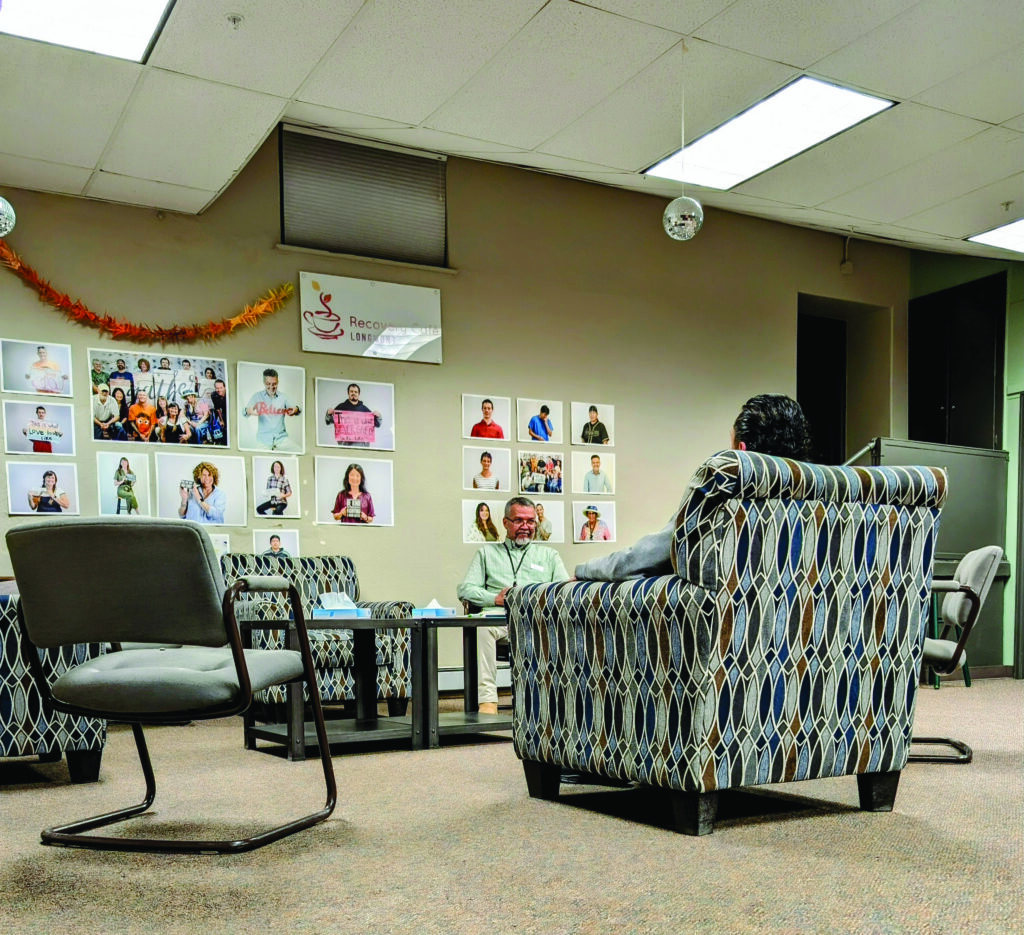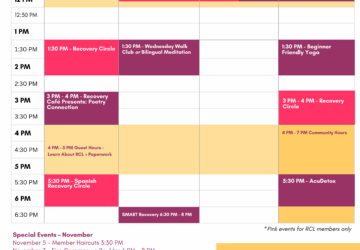On a recent Tuesday night, an area church basement serves as a community gathering space and is bustling with activity. Locals are creating works of art while others are strumming the guitar or piecing together a puzzle. Some are enjoying meals together, and a few are sharing in social circles.
It’s called Recovery Cafe Longmont. From its home on the lower floor of the Central Longmont Presbyterian Church, they have helped hundreds of people over the past six years stay sober and get on their feet during recovery.
“We like to say that everyone is in recovery from something,” said Executive Director Jennifer Jepsen. “But what we see mostly is people who are at that intersection of substance use, trauma, mental health and many have housing struggles and acute needs.
“We provide a community for them to work through those struggles, however that looks for them.”
A place to rebuild
The cafe uses a membership-based model. Members aren’t required to pay traditional monetary dues, but instead are asked to follow three rules: Do not use substances in the cafe, attend weekly recovery circles and contribute to the life of the organization.
“So many folks in recovery are having to rebuild their community,” Jepsen said. “We like to be a place for that.”
Recovery Cafe currently boasts about 50 members, all adults who receive support in many forms: nutritious meals and acupuncture of the ear from local practitioners, art and music classes, yoga and a chance to try out new material at open mic night. Open to members five days a week, the cafe also offers community hours on Friday, where anyone can drop in and experience a taste of sober living.
The Longmont location is part of a network of 77 sober cafes across the country; headquarters are based in Seattle.
The spread of recovery cafes is part of a larger sober movement; things like Dry January and “sober curious” trend on social media. Consumption of non-alcoholic beer, wine and spirits is up: sales increased 35% from 2022 to 2023, according to business magazine Fortune. Gen Z appears to be drinking less than previous generations, according to a 2023 Gallup poll. The survey showed that the percentage of people 18 to 34 who say they occasionally have an alcoholic drink has fallen from 72% to 62% over the past 20 years.

Jepsen says the cafe’s open community night is a vital sober space to gather.
“There isn’t a lot for people to do on a Friday night that doesn’t revolve around substances and alcohol,” she said, “so one thing we are striving to do is offer sober events.”
Progress, not perfection
Sometimes, the path to sobriety involves the criminal justice system. People accused of drug crimes in Boulder County can avoid additional potential prison or jail sentences if they’re willing to work a rigorous 15 to 18 months at achieving and maintaining their sobriety.
Adult Integrated Treatment Court (AITC) has about 65 participants at one time. Since its inception in 2006, 991 people have started the program and 550 have graduated.
The No. 1 drug they see abused in the Boulder community is methamphetamine, followed by alcohol and fentanyl and other synthetic opioids, the prevalence of which have increased over the last 3-5 years, according to Christina Orlowski, AITC co-coordinator.
The program is not for first-time offenders: It’s intended as a prison diversion for people with numerous arrests who have tried a number of ways to get sober in the past. The requirements are intense. AITC has five phases, which each last from two weeks to six months, and include collaborations with a number of community partners.
“You’re doing this intensive [out-patient] treatment, up to three days a week. Because we are meeting people where they are at, sometimes it’s more. Sometimes they are doing inpatient treatment,” said Orlowski. “You are going to treatment three separate days a week, you’re doing [urine analysis] testing to verify sobriety, you’re seeing your probation officer, you’re coming to court every two weeks, and by the way, make sure you’re working, and make sure we’re building those community supports behind you.”
Since the beginning of 2024, 33 participants were “negatively discharged,” compared to 29 graduates. Negative discharges are when a participant doesn’t move forward in the program because they weren’t able to complete certain requirements. Orlowski says the program is tough, but not so rigid it doesn’t allow for life’s unpredictable patterns.
“The point of the non-traditional approach is progress, not perfection,” she said. “Life is not perfect, challenges come up. Those are the tools we help with. If you have a slip up, can you be honest?”

The program receives funding from a variety of sources, including the state judicial system, probation and Boulder County. It is voluntary, but once offenders are enrolled, the program and its conditions become part of the participant’s sentence.
Most graduates are free of the criminal justice system once they graduate. A few may have restitution to pay or treatment to finish, but they are not on probation or going to prison — so long as they stay sober. Recovery Cafe receives referrals from AITC and a similar diversion program in Longmont, Jepsen said.
Some people who complete AITC do go on to reoffend. Orlowski cites a 2017 study done by AITC which found a recidivism rate of 24.6% one year post-graduation. After three years, 36% of graduates had returned to prison — nearly half the national, three-year recidivism rate for drug offenders (68%).
It’s the success stories that make Orlowski vibrate with pride. She joyfully describes graduates of the program — some of whom she’s known for over 15 years.
“I get pictures of their kids and new houses and the work that they’re doing, and it’s just incredible to see human resilience,” she said. “Watching people move through this and the professionals that we work with, they are so unseen and they are actually changing lives.”
Anatomy of alternative treatment – AITC steps and requirements
Phase 1: ORIENTATION (minimum of 2 weeks)
Initial contact with probation officer, treatment provider and monitoring agency. Probation officer reviews requirements of the program including employment, housing, etc., assigns testing agency and reviews reporting instructions. Participants attend drug/alcohol evaluation and intake appointments and begin attending assigned individual therapy and groups.
Phase 2: STABILITY (minimum of 12 weeks)
Attend scheduled court appearances, scheduled probation meetings, drug screens, weekly treatment appointments — which may include two groups per week (recovery skills, readiness group or relapse prevention) — individual therapy, and at least four support groups per week. Honesty in court and participation and investment in the treatment will be considered by the team as indicators of progress in the program.
SOBRIETY REQUIREMENT: To be eligible for promotion to Phase 3, participants must have 30 consecutive days of sobriety and be making progress in recovery.

Phase 3: SOBER LIVING SKILLS (minimum of 24 weeks)
Attend scheduled court appearances, probation meetings, drug screens, weekly treatment appointments, individual/family/couples therapy per case plan, any other treatment ordered by the court (domestic violence classes, parenting classes, etc.), three hours of community support groups or pro-social activities
SOBRIETY REQUIREMENT: To be eligible for promotion to Phase 4, participants must have 30 consecutive days of sobriety and be making progress in recovery.
Phase 4: RELAPSE PREVENTION (minimum of 12 weeks)
Attend scheduled court appearances, probation meetings, drug screens, treatment appointments (which may include weekly relapse prevention group, individual treatment per case plan), three community support groups or pro-social activities per week
SOBRIETY REQUIREMENT: To be eligible for promotion to Phase 5, participants must have 30 consecutive days of sobriety and be making progress in recovery.
Phase 5: MAINTENANCE (minimum of 12 weeks)
Attend scheduled court appearances, probation meetings, drug screens, weekly treatment appointments (which may include three community support groups or pro-social activities per week), any other treatment per case plan and at least three support groups per week.
SOBRIETY REQUIREMENT: To be eligible for graduation, participants must have attained at least 90 days of continuous sobriety.
Editor’s note: This article has been updated to correctly reflect the name of the AITC program



